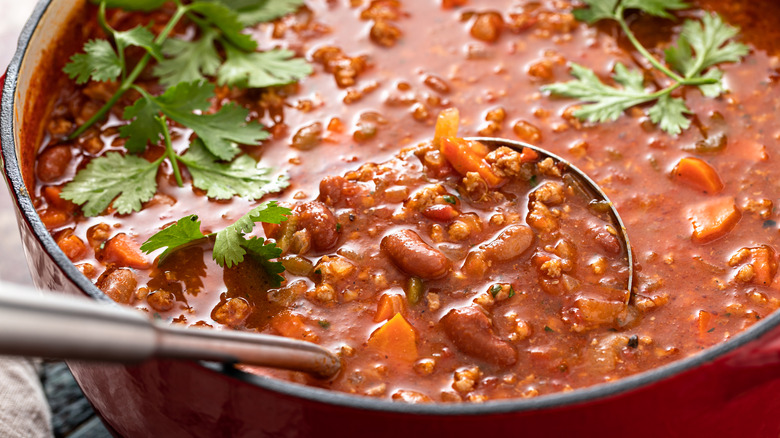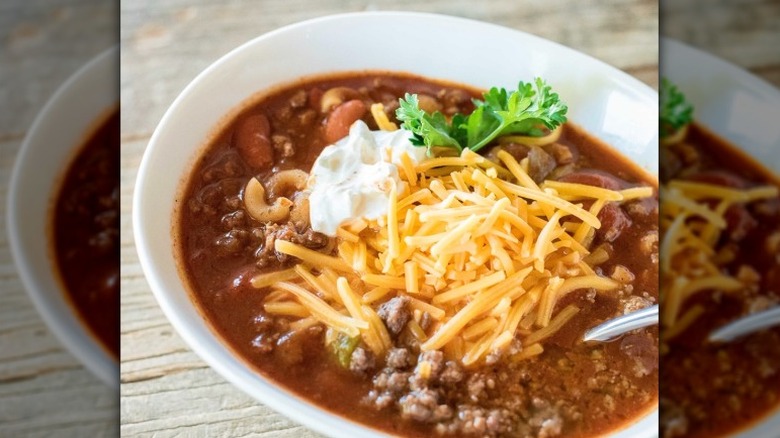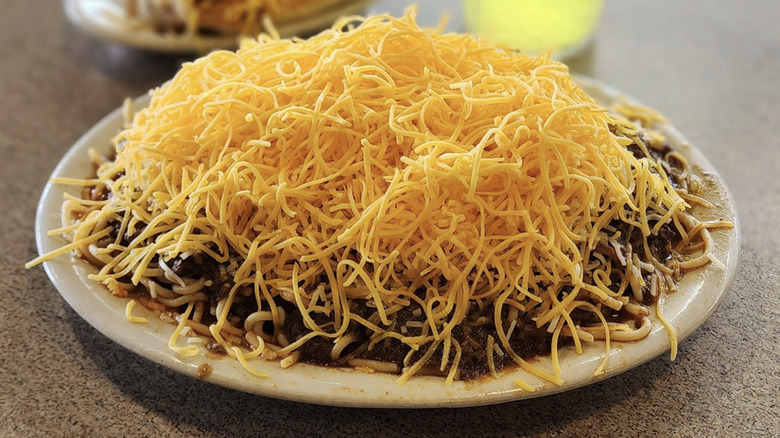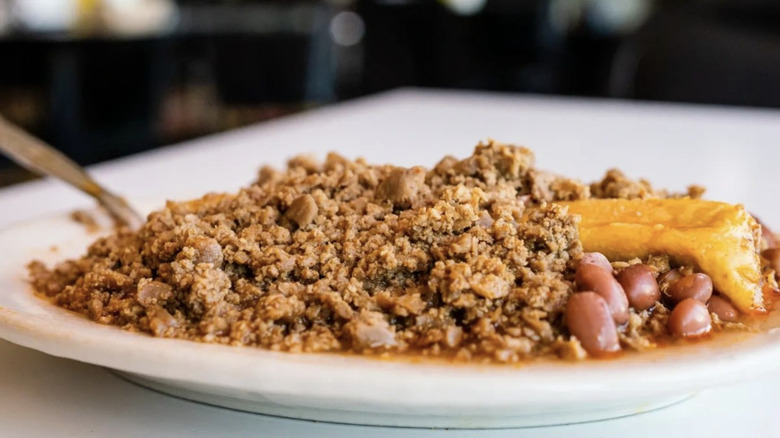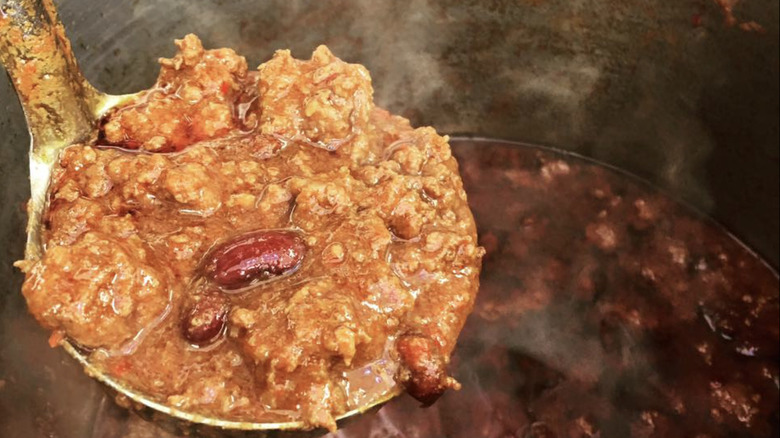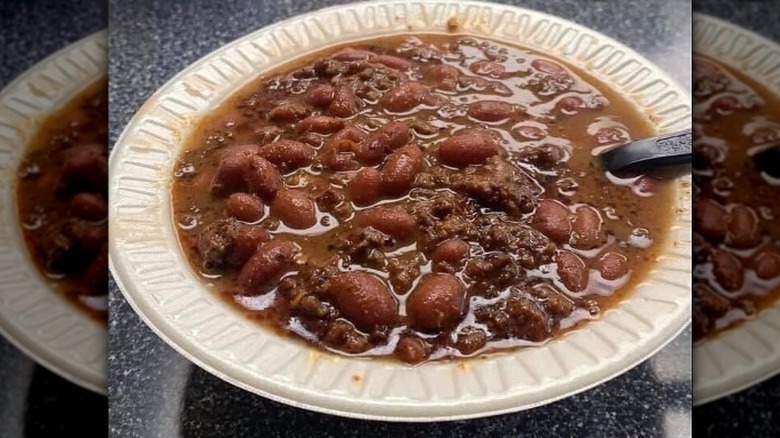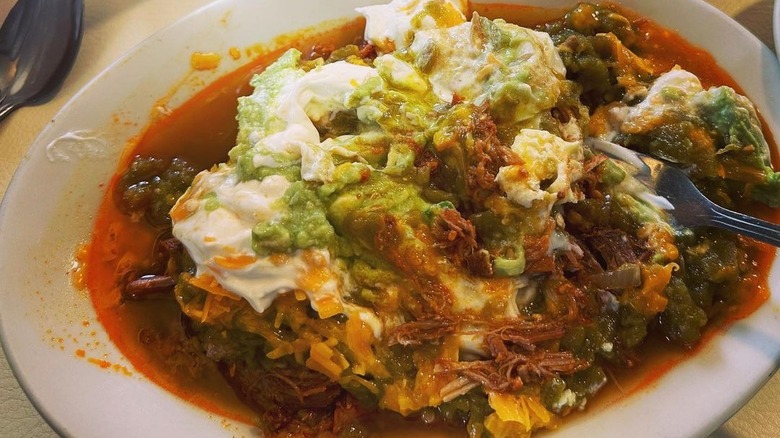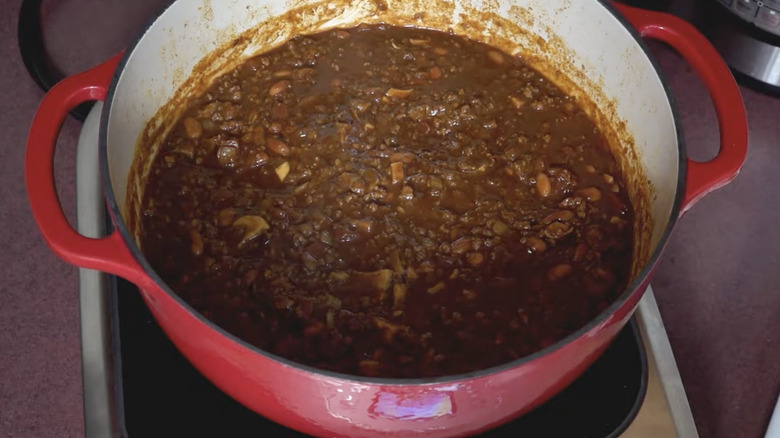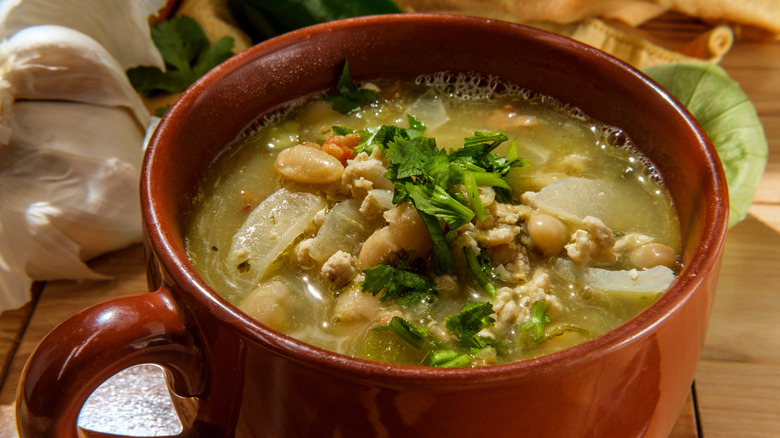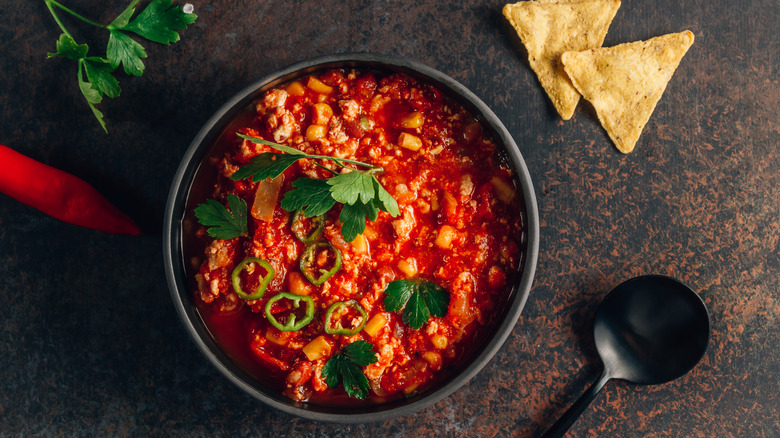Regional Chili Variations Ranked Worst To Best
Chili holds a special place in the hearts of many Americans. The nourishing dish is the epitome of comfort food, especially on chilly winter evenings. Its long-standing history in the country only adds to its appeal. Over the years, the dish has garnered significant acclaim, including being recognized as "America's greatest culinary creation" by the International Chili Society ... although it might be a bit biased.
While chili is often associated with Texas, this is far from the end of the story. The beauty of this versatile dish lies in its adaptability, which allows for a myriad of regional variations across the country. From mild to spicy, with or without beans, and featuring a wide array of meats and vegetables, chili offers endless possibilities.
Regional chili styles showcase the diverse culinary landscape of the United States. Different states have come up with their own unique takes on the flavorful dish, each with its distinct flavor profile and ingredients. This regional diversity has even sparked friendly competition among enthusiasts, cultivating the love for chili across the country. With this in mind, here's how we rank America's regional chili variations from worst to best.
10. Indiana: Hoosier chili
Chili purists aren't keen on Hoosier chili for a number of reasons. The sauce is commonly made with commercially-produced ingredients such as V8 vegetable juice or a can of RO-TEL diced tomatoes and green chilies. It also comes with beans, an addition frowned upon by some chili enthusiasts. Secondly, Hoosier chili is typically served over spaghetti, a big no-no for more conservative fans of the dish.
Its origins seem to date back to 1908 when an Indianapolis Newspaper published a recipe that included a "10 cent piece of boiling beef" and spaghetti. One of the pioneering chili vendors in the state was Dory C. Blacker. By 1924, he had successfully launched five Blacker's Chile Parlors and took the initiative to can his distinctive take on the dish. Although the exact recipe for this chili remains a secret, there have been attempts to replicate it. One such rendition calls for ground beef, suet, chili peppers, garlic, ground cumin seeds, chili beans, and optional spaghetti.
9. Ohio: Cincinnati chili
You'd be forgiven for mistaking Cincinnati chili for spaghetti since the sauce is often served on top of pasta. Thinner than most of its chili counterparts, the sauce exhibits a mild level of sweetness due to a blend of ingredients such as cinnamon, cloves, nutmeg, allspice, and sometimes even cocoa powder. Just like a standard plate of Bolognese, the dish sometimes comes topped with cheese. Given the recipe, perhaps it's not surprising that many people don't classify Cincinnati chili as chili, particularly considering its minimal use of chilies.
The roots of Cincinnati chili can be traced back to the Empress Chili Parlor, an eatery opened in 1922 by two Greek immigrants. Their version of chili was influenced by the culinary traditions of their homeland, such as moussaka, an eggplant, potato, and ground meat dish.
Cincinnati chili is sometimes called Skyline chili, referring to a local restaurant of the same name. The establishment was opened in 1949 by a former employee of the Empress, who introduced his own interpretation of the dish. Today, the chain has close to 100 locations in Ohio and a substantial presence in Kentucky and Indiana. Notably, Skyline chili is sometimes called Five-Way spaghetti because of the five different ways it's served at the restaurant.
8. Missouri: Kansas City chili
Kansas City chili is closely linked with Vergne Dixon, who opened a chili parlor in 1919. Dixon's chili was dry and thick and featured subtly seasoned ground beef and beans. For Dixon, chili was serious business — apparently, his six-stool parlor had a policy of no ketchup, smoking, reading newspapers, or talking on the phone.
Tasty chili wasn't Dixon's only claim to fame. His eatery was renowned as a hang-out spot for former President Harry S. Truman, who would also occasionally have the dish delivered. December 23, 1950, marked a memorable occasion at Dixon's when a multitude of reporters and photographers captured the president indulging in a hearty dish of chili and tamales.
Now called Dixon's Famous Chili, the parlor continues to serve its legendary chili recipe. The manager of the restaurant, Stephen Steffes, proudly shared with Kansas City Public Radio that the eatery still uses the recipe created by Vergne over a century ago, including his specially formulated chili powder. For those who like their chili on the thinner side, Dixon's also offers a "soupy" version served with additional bean broth and a "juicy" style with meat grease.
7. Michigan: Coney Island hot cog chili
Despite its name, the Coney Island hot dog might not have originated in New York, where it became Nathan's Famous claim to fame. Instead, some say that the fast-food staple topped with meaty chili, mustard, and onions had its beginnings in Michigan. While the precise origins of the Coney Island hot dog chili are unknown, there are two Detroit eateries that are often credited with the honor: American Coney Island and Lafayette Coney Island.
American Coney Island was the brainchild of a Greek immigrant, Gust Keros, who founded the hot dog restaurant in 1917. Interestingly, Keros' brother eventually opened Lafayette Coney Island right by Gust's eatery. Standing testament to Detroiters' love for the dish, both locations are still in business today.
The two hot dog joints have even gone head-to-head with their offerings on an episode of "Man v. Food." According to the show's host Adam Richman, there's a noticeable distinction between the chili at the two establishments. He explains that while American Coney Island has a saucy texture accented by Greek spices, Lafayette Coney Island's is a thicker and meatier experience.
6. Oklahoma: Oklahoma chili
Unlike some other chilis in the U.S., Oklahoma's version doesn't call for fresh peppers. Instead, the classic recipe relies on dried red chili powder combined with coarsely-chopped meat (usually beef), garlic, and onion. Other ingredients such as oregano, cumin, beef suet, and tomatoes are sometimes used. Many versions of Oklahoma chili also thicken the stew with ground cornmeal.
Oklahoma chili has a long history, drawing its roots from the state's chili parlors, which were documented in writing as early as 1897. During the first half of the 20th century, there were over 60 chili parlors in more than 30 communities, indicating that most towns would have had their own chili parlor at some stage. A recipe for the dish even made its appearance in a 1903 cookbook, which utilized ingredients such as chili peppers, meat, and cumin. And while beans don't necessarily appear in Oklahoma chili today, it's noteworthy that throughout the century they made an appearance in most versions of the dish.
5. Illinois: Springfield chilli
It's not a typo — Springfield chilli is indeed spelled unconventionally due to its association with the opening of Dew Chilli Parlor in 1909. At that time, there were already several chili vendors operating in the area, with the number expanding to 11 by 1923. Dew Chilli Parlor is still in operation serving classic American comfort dishes, many of which incorporate chili.
So how does Springfield chilli distinguish itself from its counterparts in different states? Larry Eastep, a member of the International Chili Society and an active participant in local chili cook-offs, sheds light on the topic, saying, "In Springfield, [...] chilli is made with a lot of suet, a lot of beans, and a mild spice mix with a lot of cumin" (via Illinois Times). Springfield chilli includes ground beef cooked separately from the beans, which are mixed in with the rest just before the dish is served.
4. New Mexico: Carne adovada
Just like its New Mexican sibling, chili con carne, carne adovada is characterized by a rich and meaty texture. Made with cubed or shredded pork, as well as red peppers, the dish is slow-cooked until the meat is fall-off-the-fork tender. While there's no official recipe for carne adovada, or carne adobada as it's sometimes spelled, most culinary renditions of this beloved stew feature a few key ingredients. These include the obligatory marinated pork shoulder and red chilies, as well as Mexican oregano, salt, garlic, cumin, and vinegar.
Carne adovada is generally known for its approachable heat level, which makes it a relatively mild dish that can be enjoyed by a wide range of palates. Not to mention, you can easily tailor the recipe in either direction; add more chilies to amp up the heat or enhance its approachability by balancing the kick with honey and lime.
3. Louisiana: Cajun chili
Known for its robust flavors, Cajun cuisine has been influenced by French, West African, Caribbean, and Native American culinary traditions. Aside from iconic Cajun dishes such as jambalaya and gumbo, the state of Louisiana prides itself on its Cajun chili, which combines elements of the traditional dish with its bold and spicy flavors. The dish typically features meat (often chicken or sausage), onions, bell peppers, celery, and cayenne pepper. The result is a hearty and flavorful chili with a distinct Cajun twist.
While all recipes can benefit from a touch of creativity, Cajun chili is usually made with Cajun Belle peppers. Also typically used in jambalaya and gumbo, Cajun peppers come in both red and green varieties. What sets them apart, however, is their unique combination of sweetness and relatively spicy flavor, which adds a deeply satisfying kick to Cajun dishes. Their Scoville heat rating ranges from 500 to 4,000 units, making them significantly milder than the scorching Carolina reaper, but comparable in heat to jalapeño, poblano, and mirasol peppers.
2. New Mexico: Chile verde
In New Mexico, chilies are more than just a culinary ingredient, they are a defining element of the state's identity. After all, there's a good reason why many people refer to New Mexico as the "Chile Capital of the World." The state's residents are particularly proud of their Hatch chile pepper, which is renowned for its distinctive combination of sweet and smoky flavors. It's only available in August and September, adding an air of anticipation to its arrival.
In celebration of the vibrant hue and bold flavor of its beloved ingredient, the state's signature stew takes the form of chile verde, or green chili. Interestingly, the recipe for this iconic dish is often considered elusive, with some claiming that it lacks an original version. The stew is usually made with cuts of pork, roasted green chilies, garlic, and tomatillos. While Hatch chiles are considered to be the best spice for the job, they can be substituted with other varieties of green chilies. Nevertheless, to achieve a flavor profile that closely resembles the pepper, J. Kenji López-Alt from Serious Eats recommends using a blend of cubanelle, poblano, and jalapeño peppers instead.
1. Texas: Chili con carne
Chili con carne holds a special place in the hearts of Texans, where the dish is cherished as a beloved culinary tradition. But it's not just the residents of the Lone Star state that embrace this iconic dish — the tantalizing flavors of this hearty stew have transcended borders, captivating the palates of people around the globe.
Proclaimed as the official dish of Texas in 1977, the quintessential Tex-Mex favorite is believed to have been brought to the state by Canarians who settled in Texas in the 18th century. According to Texas food historian, Robb Walsh, the flavorful blend of meat, chili peppers, onions, garlic, and cumin reflected the Moroccan culinary heritage found in the Canary Islands.
Chili con carne was popularized by the so-called Chili Queens, a group of enterprising women who served food — including tamales with chili — at San Antonio's Military Plaza from the 1860s onward. However, it was the Chicago Exposition of 1893 that truly propelled Texas chili onto the national stage. A food stand serving chili con carne delighted the taste buds of visitors from all corners of the country. Inspired by the delectable flavors, some of these visitors returned home and opened their own chili parlors, spreading appreciation for the flavorful stew throughout the nation.
